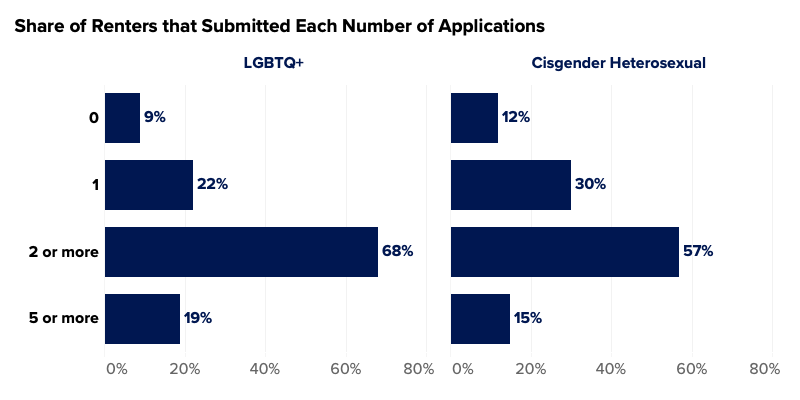LGBTQ+ renters comprise about one in eight of all renters and one in five of those that moved recently, according to new analyses of the 2022 Consumer Housing Trends Report (CHTR). These LGBTQ+ renters face disproportionate hurdles to finding housing, like higher costs in areas that protect them from housing discrimination and a higher frequency and likelihood of paying upfront costs like application fees and security deposits.
Gender Identity & Sexual Orientation

In 2022, approximately 13% of renters identify as gay, lesbian, bisexual, transgender, gender non-conforming/non-binary, intersex, or with another sexual orientation (other than straight) or gender identity (e.g. gender fluid, gender queer, gender neutral). Recent renters – renters who moved within the last year – are more likely to identify as LGBTQ+ (18%) than are tenured renters (12%).
Taking a longer view, we see some modest change in the share of recent renters who identified as LGBTQ+. In 2019, about one in ten (11%) recent renters identified as LGBTQ+, followed by 16% in 2020 before plateauing in the last couple years: 22% in 2021, and 18% in 2022. This share – about 1 in 5 recent renters – represents millions of renters moving each year. A number of factors may explain the 2021-2022 trend, even if our data do not allow us to examine them directly. One possible explanation may be rising rents forcing LGBTQ+ renters to stay in place. Another reason may be that higher housing costs caused LGBTQ+ renters to consolidate into households where they were no longer household decision makers (and would not be captured in our survey). LGBTQ+ renters have historically been more likely to have roommates and often have larger households than their cisgender heterosexual counterparts.
Beneath this larger pattern are key age trends; younger renters are more likely to self-identify as LGBTQ+: The median age of an LGBTQ+ renter is 29 – versus 41 for cisgender heterosexual renters. Renters trending younger than the US adult population as a whole may help explain why renters are also more likely to identify as LGBTQ+.
Applications & Application Fees
LGBTQ+ renters continue to face hardships in the housing market, especially compared with their cisgender, heterosexual peers. LGBTQ+ renters were more likely to report paying an application fee: 66% of LGBTQ+ renters said they paid one – higher than 57% of cisgender heterosexual renters. LGBTQ+ renters are also more likely to submit a greater number of applications in their rental search: 68% submit two or more – compared to 57% for cisgender heterosexual renters. And 19% submit 5 or more applications – just above 15% for cisgender heterosexual renters. In other words, LGBTQ+ renters generally face higher upfront costs than their peers.

LGBTQ+ renters are also about 28% more likely to report moving in the last year than cisgender heterosexual renters. This higher move likelihood means that LGBTQ+ renters not only disproportionately feel the effect of upfront costs of moving, they tend to experience them more often. This trend is largely attributable to age: Renters under 30 are 80% more likely to report moving in the past year than those age 30 and older, and younger renters are more likely to identify as LGBTQ+ than are older renters.
These disparities are not new. Prior Zillow research has found that LGBTQ+ renters experience bigger rent increases and are less likely to get their security deposit returned.
While some progress has been made towards equality in recent years, LGBTQ+ community continues to face additional huddles when finding housing.








